Simon Lancaster and David Read examine the current phenomenon that empowers students to take control of their own learning
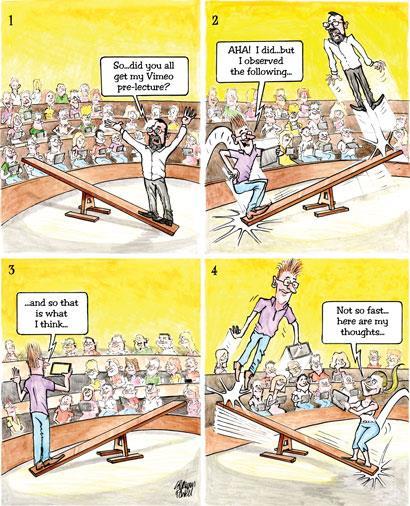
The concept of 'flipped teaching' is currently a hot topic at all levels of education. The basic premise is nothing new: the teacher provides guidance and materials that students then digest in their own time before the next session. Completing the assigned tasks gives students knowledge and understanding and allows the teacher to make more effective use of precious face-to-face contact time.While in the past the 'flipped' activity might have involved something as simple as reading a chapter in a textbook, recent developments in learning technology have opened up an exciting range of opportunities for inverting the classroom at both university and school level.
The challenge of the lecture
The ancient practice of lecturing has survived the advent of the printing press, video and now the internet, perhaps in part because lectures are thought to be the most efficient means of delivering higher education. The on-going investments in physical infrastructure suggest that this is indeed considered to be the case. However, while many lecturers might feel that the format worked for them, how much learning really takes place in lectures?
Recent studies have suggested that students are no more attentive in lectures than while watching television, and evidence is accumulating that even the most charismatic and theatrical lecturer cannot overcome this fundamental problem. If the primary purpose of a lecture is to simply convey information, surely 21st century technology presents us with better means for delivery?
The schools of chemistry at the Universities of East Anglia (UEA) and Southampton are early adopters of various educational technologies. The majority of our first year lectures are recorded and made available to students on virtual learning environments to complement lecture notes.1 The service is popular with students, but has had no discernible negative impact on lecture attendance.2 This pre-recorded material also provides an alternative means for the delivery of course content as an online resource, as well as being useful revision material.
Staff at both universities have also explored the use of voting pads (clickers) to enhance interactivity and gauge students' understanding during lectures. Incorporating interaction in lectures uses up teaching time and, if it is to genuinely support learning, students must pause to reflect on their understanding. Once answers have been polled, they must then be digested and reacted to. This presents tough decisions for educators to make: should we cut coverage to make way for interaction? And if students do not react the way we wish, should we plough on regardless, or revise our approach to take account of the needs of students?
Stick or twist?
The 'flipped teaching' model can be a solution to this dilemma. The term, normally attributed to Bergman and Sams, should not be thought of as a particular set of practices, but more as a philosophy that places the student and not the lecturer at the centre of the learning process. There is no one way to flip teaching, but all the variations aim to encourage preparation in advance for a much richer learning experience in a face-to-face session.
With an archive of screencasts and experience with student polling, chemistry at UEA was ideally placed to experiment with lecture flipping. In the 2011–12 academic year, the department performed an initial trial on a second year module. Instead of attending lectures, the students watched screencasts of three lectures recorded the previous year. During the timetabled lectures, the students instead participated in interactive sessions where their ability to apply their flipped learning was tested.
For example, students answered multiple choice questions using voting pads: where the vast majority of students showed clear understanding, the session progressed to the next topic, but where confusion or misconception was revealed, the staff member could further discuss the area.
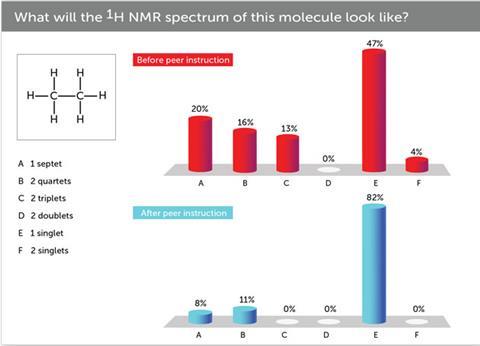
Peer instruction was another successful approach. When a cohort of students returned a range of answers to a multiple choice question, the students then found someone nearby they disagreed with in order to exchange explanations before the question was polled again (right).
Since chemistry is a very visual subject, students frequently need to be able to represent their answers in the form of diagrams. This is a skill that is not easily probed using multiple choice questions. However, the use of personal whiteboards does allow the checking of students' ability to correctly draw a diagram, even in a large lecture setting. By asking the students to hold their boards up facing the lecturer, the liberating anonymity can be preserved.
Having long been in the vanguard of teaching innovation, we are used to students enthusiastically embracing initiatives. However, it is not just the positivity of students towards lecture flipping that is striking, but their willingness to present explanations of what it is about the process that appeals. (Student evaluation comments for a second year inorganic chemistry module – comments collected from the one second year module that had just three flipped sessions).
In the 2012–13 academic year we extended the practice to modules in years one, two and four of our degree programmes. Wherever the weight of content is crushing interactivity, or the current approach appears ineffective, flipping teaching may have a role in enhancing students' learning.
Student evaluation comments for a second year inorganic chemistry module
'I really enjoyed the flipped lectures and find that revising that material is much easier.'
'The flipped lectures are a definite step in the right direction, away from archaic lectures with little or no mental stimulus, towards a more interactive learning experience that maximises learning outcome!'
'They were good fun as it was nice to have interaction with the lecture as opposed to just being talked at, it was also nice having knowledge of what you were talking about as we had already gone through the material!'
'I think the flipped lectures were a really good idea because it was a more interactive way to engage students into learning, rather than the repetitive routine of having to listen to the lecturer work through a PowerPoint presentation for an hour.'
Back to school
At the school level, increasing numbers of teachers are inverting their classrooms. This releases them from the shackles of content delivery and empowers students to take control of their learning. Anyone can flip their teaching. Below are two examples of teachers flipping their A-level chemistry teaching.
Sam Shadbolt at Bicester Community College trialled recording videos of himself writing out notes (ie the 'content') accompanied by verbal explanations. Shadbolt shared the videos with his students via Vimeo to allow them to watch them before class. Students are provided with a timetable outlining the content of lessons and which videos need to be watched in advance of each session. Lessons invariably begin with a recap of the online material, in many cases using personal whiteboards to gauge understanding.
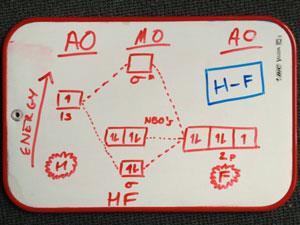
Prior knowledge of the content facilitates more effective group and practical work during lessons, while the teacher is free to support, encourage and cajole students, and provide formative feedback. The approach also appears to facilitate more effective differentiation to support students across the ability spectrum.
As well as making the usual comment that it was helpful to be able to revisit the videos on demand, students at Bicester also remarked that 'preparation before work makes it easier to learn' and that 'there is more time for help'. Furthermore, it was also suggested that 'lessons are more fun and there's more time to revise' and there was a 'more relaxed atmosphere (with) less pressure'. A tip for teachers is to remember to break the content down in the face-to-face session, acknowledging that while students have a full set of notes, they may not yet understand how it all fits together.
At Alton College, Fiona Revell inverted the classroom with a view to developing independent learning skills, and helping students to apply their learning more effectively in answering challenging exam questions. A key feature of the project has been the use of the free voting tool Socrative to determine students' understanding of the flipped material at the start of face-to-face sessions.
From a teacher perspective, the use of Socrative created a real buzz and a purposeful atmosphere, while also highlighting which aspects of different topics were proving troublesome to the students. The responses from students were again insightful, with example comments (Comments from Alton College students) indicating that they genuinely appreciated the importance of completing the work before the face-to-face sessions.
Comments from Alton College students
'Socrative quizzes are great, especially when they get competitive. I also enjoyed the flipped lessons because we were not left with much option besides learning the subject thoroughly.'
'Flipped lessons worked well, as I worked hard so I would know the answers for in class, and it would be obvious if anybody had not pre-prepared for the lesson.'
'Flipped lessons were unusual above all else, but in a good way. They put pressure on me to grasp an understanding of the topic before the lesson itself.'
Conclusions
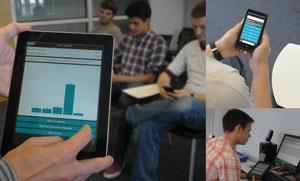
Flipped teaching is a powerful strategy to address some of the weaknesses of traditional teaching. It can empower students to take control of their own learning by moving the presentation of content to before the contact time and active engagement. For educators it can be liberating to be free from the burden of content delivery and there are a range of approaches available, allowing them to find a method to best suit their preferences.
However, it is essential that flipped teaching is not exploited as a means of reducing contact time, particularly at a time when there is immense pressure on budgets across the education sector. After all, the key advantages of the inverted classroom manifest themselves during face-to-face taught sessions, where students are at the heart of the learning process and teachers can add maximum value as informed facilitators.
Simon Lancaster is a senior lecturer in chemistry at the University of East Anglia. David Read is a principal teaching fellow in chemistry at the University of Southampton.
References
- Education in Chemistry, July 2012, p13 (Unlocking video: 24/7 learning for iPod generation)
- C K Andrews et al, New Dir. Teach. Phys. Sci., 2010, 6, 56 (http://bit.ly/oyHb2g)
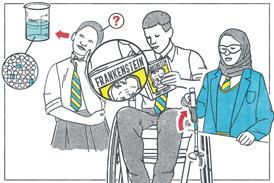








No comments yet